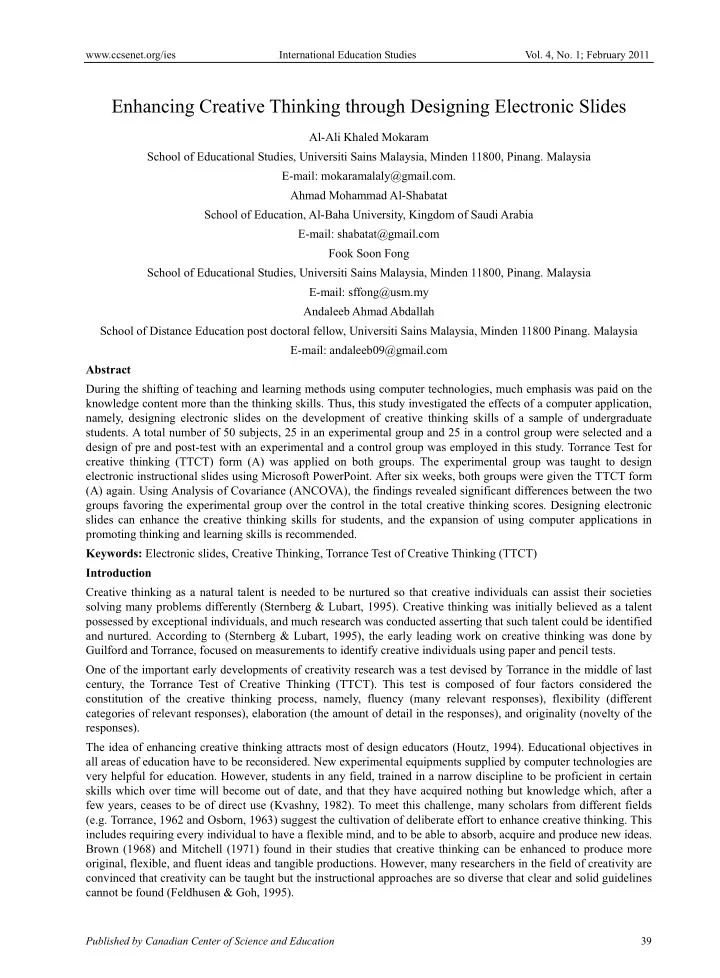

www.ccsenet.org/ies International Education Studies Vol. 4, No. 1; February 2011 Enhancing Creative Thinking through Designing Electronic Slides Al-Ali Khaled Mokaram School of Educational Studies, Universiti Sains Malaysia, Minden 11800, Pinang. Malaysia E-mail: mokaramalaly@gmail.com. Ahmad Mohammad Al-Shabatat School of Education, Al-Baha University, Kingdom of Saudi Arabia E-mail: shabatat@gmail.com Fook Soon Fong School of Educational Studies, Universiti Sains Malaysia, Minden 11800, Pinang. Malaysia E-mail: sffong@usm.my Andaleeb Ahmad Abdallah School of Distance Education post doctoral fellow, Universiti Sains Malaysia, Minden 11800 Pinang. Malaysia E-mail: andaleeb09@gmail.com Abstract During the shifting of teaching and learning methods using computer technologies, much emphasis was paid on the knowledge content more than the thinking skills. Thus, this study investigated the effects of a computer application, namely, designing electronic slides on the development of creative thinking skills of a sample of undergraduate students. A total number of 50 subjects, 25 in an experimental group and 25 in a control group were selected and a design of pre and post-test with an experimental and a control group was employed in this study. Torrance Test for creative thinking (TTCT) form (A) was applied on both groups. The experimental group was taught to design electronic instructional slides using Microsoft PowerPoint. After six weeks, both groups were given the TTCT form (A) again. Using Analysis of Covariance (ANCOVA), the findings revealed significant differences between the two groups favoring the experimental group over the control in the total creative thinking scores. Designing electronic slides can enhance the creative thinking skills for students, and the expansion of using computer applications in promoting thinking and learning skills is recommended. Keywords: Electronic slides, Creative Thinking, Torrance Test of Creative Thinking (TTCT) Introduction Creative thinking as a natural talent is needed to be nurtured so that creative individuals can assist their societies solving many problems differently (Sternberg & Lubart, 1995). Creative thinking was initially believed as a talent possessed by exceptional individuals, and much research was conducted asserting that such talent could be identified and nurtured. According to (Sternberg & Lubart, 1995), the early leading work on creative thinking was done by Guilford and Torrance, focused on measurements to identify creative individuals using paper and pencil tests. One of the important early developments of creativity research was a test devised by Torrance in the middle of last century, the Torrance Test of Creative Thinking (TTCT). This test is composed of four factors considered the constitution of the creative thinking process, namely, fluency (many relevant responses), flexibility (different categories of relevant responses), elaboration (the amount of detail in the responses), and originality (novelty of the responses). The idea of enhancing creative thinking attracts most of design educators (Houtz, 1994). Educational objectives in all areas of education have to be reconsidered. New experimental equipments supplied by computer technologies are very helpful for education. However, students in any field, trained in a narrow discipline to be proficient in certain skills which over time will become out of date, and that they have acquired nothing but knowledge which, after a few years, ceases to be of direct use (Kvashny, 1982). To meet this challenge, many scholars from different fields (e.g. Torrance, 1962 and Osborn, 1963) suggest the cultivation of deliberate effort to enhance creative thinking. This includes requiring every individual to have a flexible mind, and to be able to absorb, acquire and produce new ideas. Brown (1968) and Mitchell (1971) found in their studies that creative thinking can be enhanced to produce more original, flexible, and fluent ideas and tangible productions. However, many researchers in the field of creativity are convinced that creativity can be taught but the instructional approaches are so diverse that clear and solid guidelines cannot be found (Feldhusen & Goh, 1995). Published by Canadian Center of Science and Education 39
Recommend
More recommend